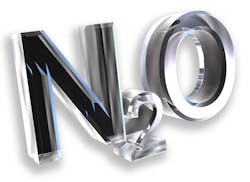Being careful with nitrous: Limit exposure risks with the use of nitrous in the dental setting
By Noel Kelsch, RDH, RDHAP, MS
There are simple things we do on a daily basis in the dental setting that keep us all out of harm’s way. Sometimes we just get into a routine and do not see the impact of harmful things being overlooked. Three things are there to keep you and your patient safe: engineering, administrative, and work practice controls. There are steps using these concepts that have been recommended for many years to minimize exposure to nitrous oxide (N2O) during dental procedures.
It has long been known that delivery of nitrous oxide to patients can expose dental workers to this anesthetic gas, which does have an impact on the clinician. This can range from short-term behavior to long-term reproductive health impacts. It has been shown in several studies that acute exposure to nitrous oxide may cause a variety of symptoms for the clinician, such as lightheadedness, eye and upper airway irritation, cough, shortness of breath, and decreases in mental performance and manual dexterity. Chronic exposure to high levels of nitrous oxide among female dental assistants who worked in offices where scavenging equipment was not used was associated with an increased risk of spontaneous abortion and reduced fertility. Occupational exposure to nitrous oxide has also been associated with an increased risk of neurologic, renal, and liver disease.1-3
The National Institute for Occupational Safety and Health (NIOSH) recently conducted a web-based survey of dental professionals including dentists, hygienists, and assistants with 284 respondents, to look at their compliance levels in use of nitrous oxide regarding engineering, administrative, and work practice controls. To participate in the survey, you had to have administered nitrous oxide within seven days of taking the survey. They looked at those serving adult patients and those serving pediatric patients. The findings were both good and not so good.4
Engineering controls are equipment and products that are designed specifically to minimize hazards (e.g., an exhaust ventilation system). The implementation of primary engineering controls (i.e., nasal scavenging mask and/or local exhaust ventilation [LEV] near the patient’s mouth) was high, at 93% and 96% of respondents who administered to adult (A) and pediatric (P) patients, respectively. This control should be at 100% - no excuses. Not using this tool puts both you and the patient at risk. If you are breathing in nitrous oxide, you become partially sedated and risk harming your patient. Using this engineering control is not a suggestion. It is a requirement.
Work practice controls are developed to reduce likelihood of harm by altering the way a task is performed (e.g., the scoop method of recapping needles). This is where many were lacking in this study. Work practice controls are developed to decrease risk to employees by having protocols in place to follow when working with nitrous oxide. The work practices that increased exposure risk in this survey were shocking:
- Not checking nitrous oxide equipment for leaks: 41% A, 48% P
- Starting nitrous oxide gas flow before delivery mask or airway mask was applied to patient: 13% A, 12% P
- Not turning off nitrous oxide gas flow before turning off oxygen flow to the patient: 8% A, 7% P
Administrative controls provide training, procedures, and policies that will decrease the risk of hazard to the clinician. Many of these controls change the behavior of people, as opposed to removing the hazard (e.g., training staff to check hosing and bag condition for leaks before turning the nitrous oxide on for every patient). In the survey, 13% of respondents said that the office did not have standard procedures to minimize worker exposure to nitrous oxide. Three percent responded that they were not being trained on safe handling and administration of nitrous oxide. Each of these acts puts people at risk.
We all have a responsibility to our patients and to staff. Those responsibilities should have engineering, administrative, and work practice controls in place that address successful management of nitrous oxide emissions, including properly fitted nasal scavenging masks; supplemental LEV (when nitrous oxide levels cannot be adequately controlled using nasal masks alone); adequate general ventilation; regular inspection of nitrous oxide delivery and scavenging equipment for leaks; availability of standard procedures to minimize exposure; periodic training; ambient air and exposure monitoring; and medical surveillance.3 These practices can and do effectively reduce nitrous oxide levels in the dental setting to 25 ppm during analgesia administration, which is the NIOSH standard.5 It is important to remember that, according to NIOSH,5 uncontrolled exposures have exceeded 1,000 ppm.
NIOSH supplies a great sheet you can post in your office to help you remember what you should be doing to keep both you and the patient safe. To find the related NIOSH Technical Data Sheet, go to cdc.gov/niosh/docs/hazardcontrol/pdfs/hc3.pdf.
According to its website,5 NIOSH recommends air sampling for N2O be conducted periodically.
Sampling can be used to measure personal breathing zone exposures of dental workers, and to detect leaks in the anesthetic delivery system, ineffective capture by the scavenging system, reentry in the room ventilation system, and circulation to other areas of the dental offices.
OSHA-recommended work practice controls
The Occupational Safety and Health Administration (OSHA), the employee regulatory agency, gives the following work practice controls:
- “Prior to first use each day of the N2O machine and every time a gas cylinder is changed, the low-pressure connections should be tested for leaks. High-pressure line connections should be tested for leaks quarterly. A soap solution may be used to test for leaks at connections. Alternatively, a portable infrared spectrophotometer can be used to detect an insidious leak.
- Prior to first use each day, inspect all N2O equipment (e.g., reservoir bag, tubing, mask, connectors) for worn parts, cracks, holes, or tears. Replace as necessary.
- Connect mask to the tubing and turn on vacuum pump. Verify appropriate flow rate (i.e., up to 45 L/min or manufacturer’s recommendations).
- A properly sized mask should be selected and placed on the patient. A good, comfortable fit should be ensured. The reservoir (breathing) bag should not be over- or underinflated while the patient is breathing oxygen (before administering N2O).
- Encourage the patient to minimize talking, mouth breathing, and facial movement while the mask is in place.
- During N2O administration, the reservoir bag should be periodically inspected for changes in tidal volume, and the vacuum flow rate should be verified.
- On completing anesthetic administration and before removing the mask, non-anesthetic gases/agents should be delivered to the patient for a sufficient time based on clinical assessment that may vary from patient to patient. In this way, both the patient and the system will be purged of residual N2O. Do not use an oxygen flush.”3
Author’s note: To see the administrative and engineering controls, go to osha.gov/dts/osta/anestheticgases and scroll down to dentistry.
Did you know?
Most nitrous oxide hoods/nosepieces are either disposable single-use items (i.e., used one time and disposed of, cannot be reprocessed) or they are to be cleaned and then sterilized in the autoclave or sterilizer, not just disinfected with a wipe or spray. Read the instructions for use for your hood/nosepiece and follow them. RDH
References
1. Rowland AS, Baird DD, Weinberg CR, Shore DL, Shy CM, Wilcox AJ. Reduced fertility among women employed as dental assistants exposed to high levels of nitrous oxide. N Engl J Med. 1992;327(14):993-997.
2. Howard WR. Nitrous oxide in the dental environment: Assessing the risk, reducing the exposure. J Am Dent Assoc. 1997;128:356-360.
3. Anesthetic Gases: Guidelines for Workplace Exposures. United States Department of Labor Occupational Safety and Health Administration website. https://www.osha.gov/dts/osta/anestheticgases/#C1. Published July 20, 1999. Updated May 18, 2000. Accessed July 9, 2017.
4. Boiano JM, Steege AL, Sweeney MH. Exposure control practices for administering nitrous oxide: A survey of dentists, dental hygienists, and dental assistants. J Occup Environ Hyg. 2017;14(6):409-416. doi: 10.1080/15459624.2016.1269180.
5. https://www.cdc.gov/niosh/docs/hazardcontrol/hc3.html
NOEL BRANDON KELSCH, RDH, RDHAP, MS, is a syndicated columnist, writer, speaker, and cartoonist. She serves on the editorial review committee for the Organization for Safety, Asepsis and Prevention newsletter and has received many national awards. Kelsch owns her dental hygiene practice that focuses on access to care for all and helps facilitate the Simi Valley Free Dental Clinic. She has devoted much of her 35 years in dentistry to educating people about the devastating effects of methamphetamines and drug use. She is a past president of the California Dental Hygienists’ Association.

